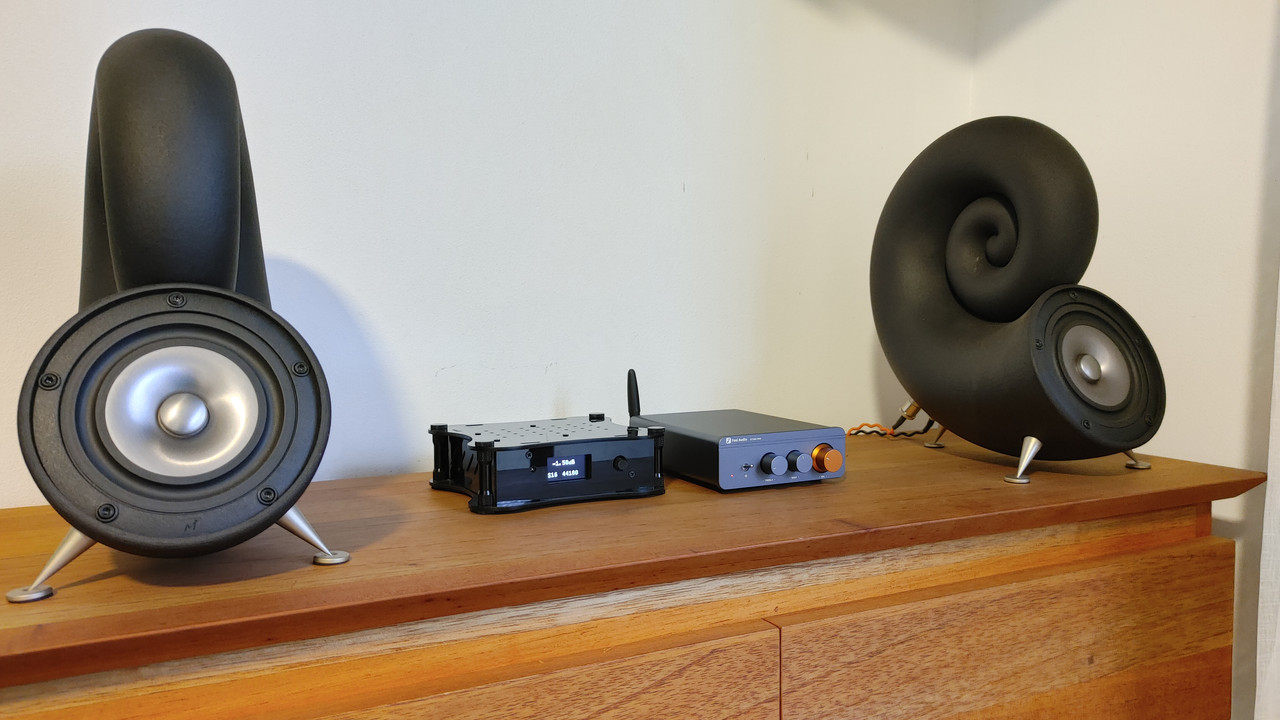Walt B
New member
- Joined
- Apr 27, 2024
- Messages
- 2
Hi Folks, this is my first post in here I hope I tailoret it to the right section.
I recently finished my last pair of custom made speakers based on Akamake's project designed by Ondra Chotovinsky.
These are the details:
Drivers: Mark Audio Alpair 7ms
Revc= 7.200 Ohm
Fo= 74.724 Hz
Sd= 50.270 cm²
Vas= 4.968 Ltr
Cms= 1.384m M/N
Mmd= 3.072m Kg
Mms= 3.277 g
BL= 3.859 TM
Qms= 2.350
Qes= 0.744
Qts= 0.565
Levc= 124.716u H
No= 0.270 %
SPLo= 86.324 dB
Xmax = 4.5mm 1 way mech
PWR= 15 Watts Nom
Box: Custom Spirula shaped printed in one piece using SLS printer using Nylon 12 material powder
Mass: 2,5 KG per unit
Supra Classic-2.5 Speaker wire (13 AWG) for internal connections
Dayton Audio BPP-SN Premium Binding Post
Dayton DSS3-SN speaker spikes
Actually I'm using a Fosi Audio BT20A PRO Class D amplifier powering these speakers. By the way I thing this is a great one from a respectable company.
This is how it looks like:

So basically, what I need is to take the measurements for:
- Frequency Response
- THD down to < 0,1% and THD at high SPL levels (up to drivers thermal or mechanical limit)
- Waterfall / spectral decay
Sumarizing what I need is:
Best affordable setup for reliable measures, what mic and what software do you recommend for entry level.
Just in case I have purchased a DaytonAudio iMM-6 mic, for tunning my daughter's violin, do you think is too basic?
I will appreciate any help you may provide.
Best regards,
Walt B.
I recently finished my last pair of custom made speakers based on Akamake's project designed by Ondra Chotovinsky.
These are the details:
Drivers: Mark Audio Alpair 7ms
Revc= 7.200 Ohm
Fo= 74.724 Hz
Sd= 50.270 cm²
Vas= 4.968 Ltr
Cms= 1.384m M/N
Mmd= 3.072m Kg
Mms= 3.277 g
BL= 3.859 TM
Qms= 2.350
Qes= 0.744
Qts= 0.565
Levc= 124.716u H
No= 0.270 %
SPLo= 86.324 dB
Xmax = 4.5mm 1 way mech
PWR= 15 Watts Nom
Box: Custom Spirula shaped printed in one piece using SLS printer using Nylon 12 material powder
Mass: 2,5 KG per unit
Supra Classic-2.5 Speaker wire (13 AWG) for internal connections
Dayton Audio BPP-SN Premium Binding Post
Dayton DSS3-SN speaker spikes
Actually I'm using a Fosi Audio BT20A PRO Class D amplifier powering these speakers. By the way I thing this is a great one from a respectable company.
This is how it looks like:

So basically, what I need is to take the measurements for:
- Frequency Response
- THD down to < 0,1% and THD at high SPL levels (up to drivers thermal or mechanical limit)
- Waterfall / spectral decay
Sumarizing what I need is:
Best affordable setup for reliable measures, what mic and what software do you recommend for entry level.
Just in case I have purchased a DaytonAudio iMM-6 mic, for tunning my daughter's violin, do you think is too basic?
I will appreciate any help you may provide.
Best regards,
Walt B.


